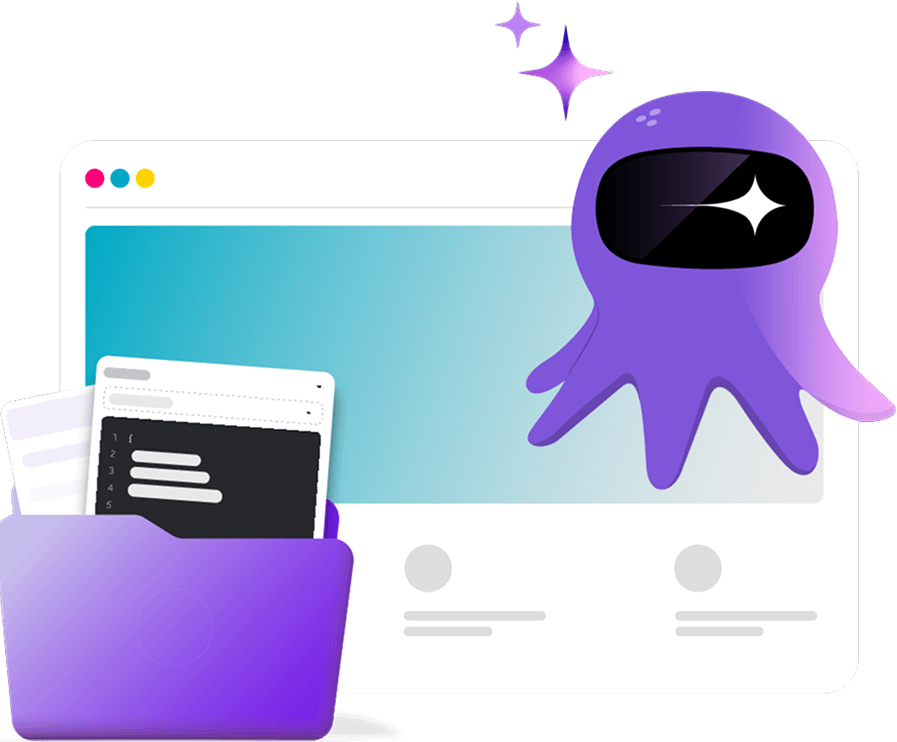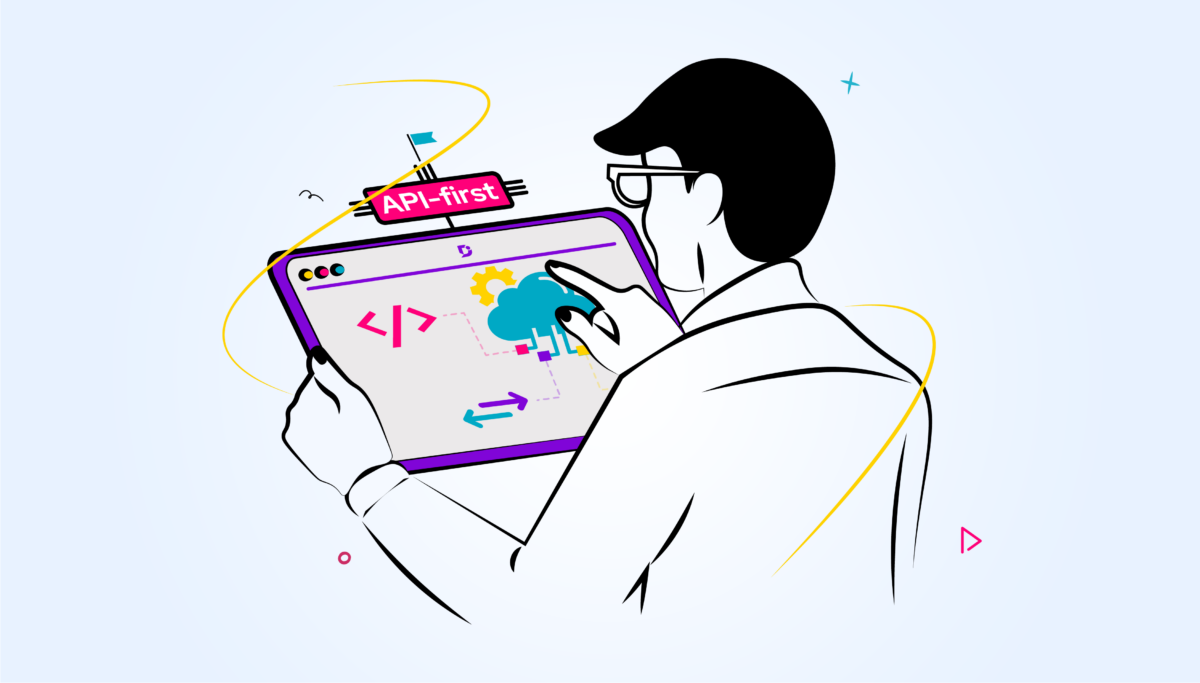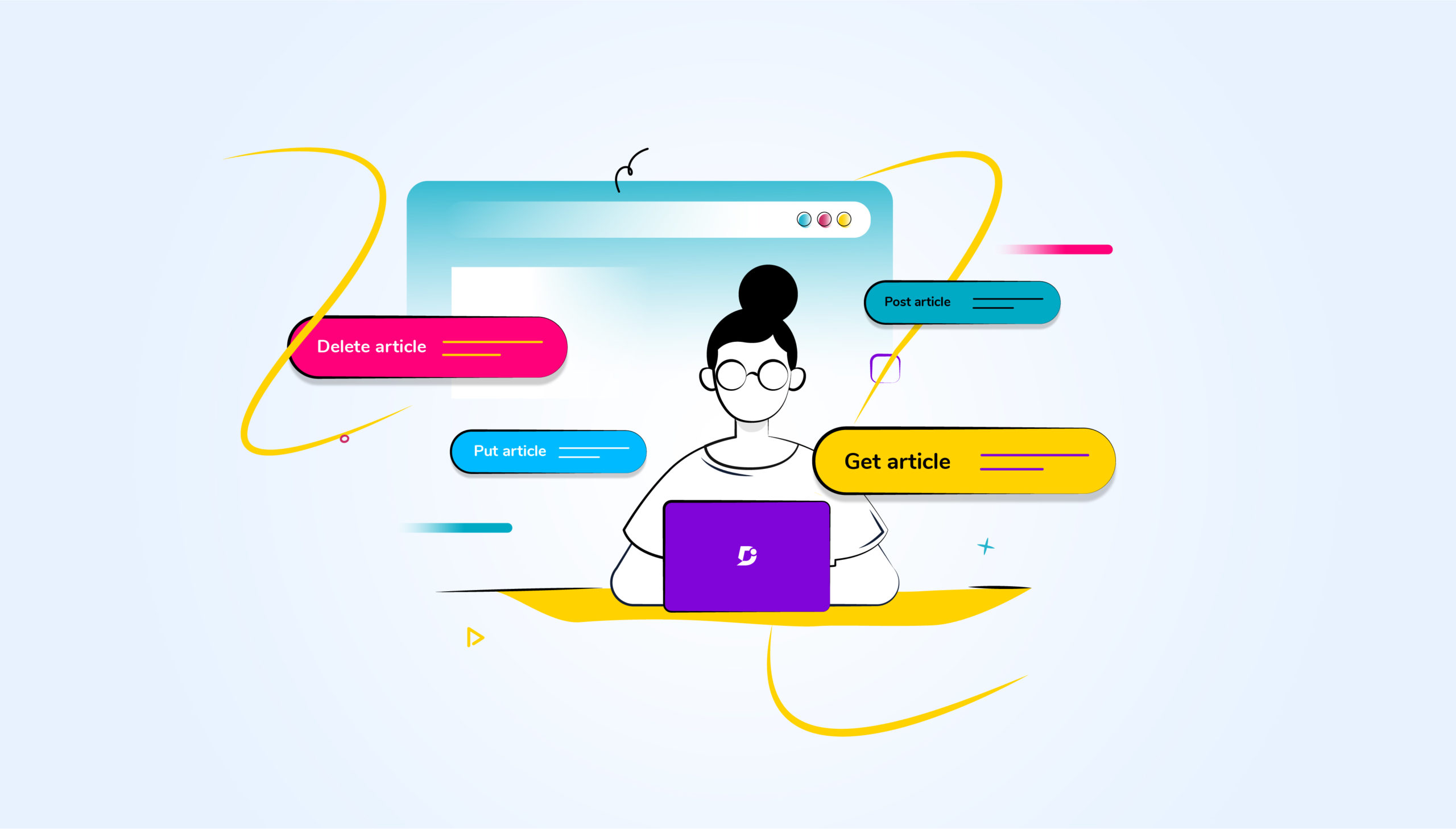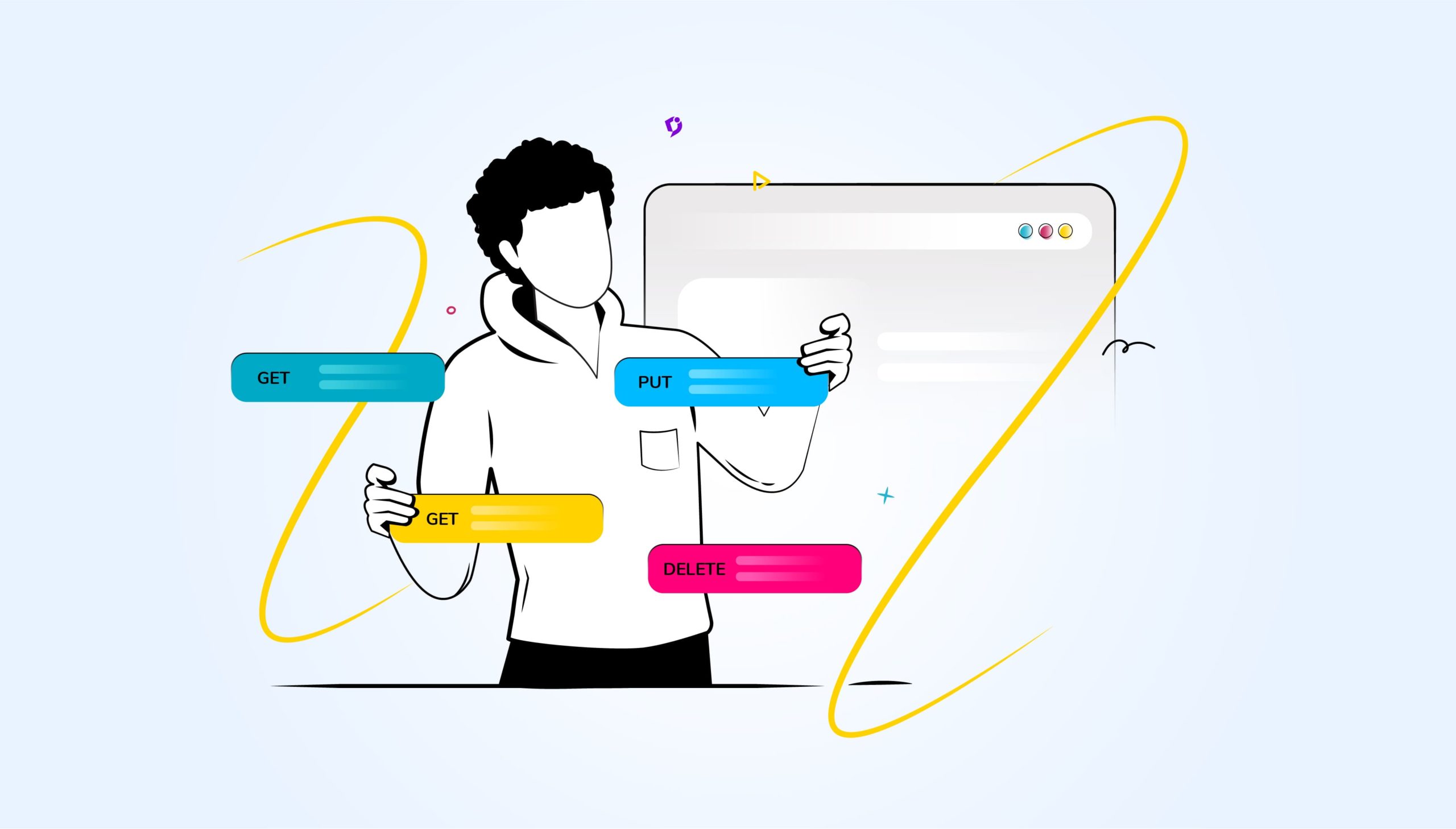API-First is one of a few API development approaches. So let’s define what the ‘API development approach’ is and explore the available options.
An API development approach is a methodology for designing, developing, deploying, and managing an API (Application Programming Interface). It provides the framework for creating an API, including planning, documenting, implementing, testing, and maintaining. The three most commonly adopted API development approaches are:
-
- Code-First
- Design-First
- API-First
You do not need to adopt these approaches individually. Instead, you can use variations or hybrid methods that better fit your project requirements.
In the end, you should choose the approach based on project complexity, your team dynamics, how much upfront planning is needed, requirements flexibility, and integration needs.
Deep Dive: API Development Approaches
Approach #1: Code-First
The Code-First approach to API development involves designing and implementing an API through code. The API specification comes after building the API.
Developers skip a formal design phase. Instead, they interpret basic requirements to define the API endpoints, request/response schemas, and business logic. Then, they use tools and frameworks like OpenAPI to generate an API specification, documentation, and other artifacts.
Using this approach, the ‘code’ is the single source of truth over the API specification.
Here is an overview of the Code-First approach:
Focus:
-
- Design the API through coding and generate the associated artifacts later.
Benefits:
-
- No Design phase to slow down development.
- Dev Team has the freedom to implement changes as project requirements evolve.
The API specification is closely coupled with the API implementation.
Challenges:
-
- Lack of clarity, effective communication, consistency, and coordination between teams.
- Making changes during development is more costly than during the Design phase.
The following is an overview of Code-First’s key components:
Design through Code
Instead of starting with a formal API specification or design document, developers begin by writing the actual code that implements the API endpoints and the associated logic. Then, they define the API’s request/response models, authentication mechanisms, and other aspects of the code.
Frameworks and Annotations
Developers use frameworks and libraries to annotate the code with API details. These frameworks can parse the code and generate an API specification. Using the specification, they use tools like Swagger to generate API documentation, client SDKs, and artifacts. Automation helps ensure consistency and reduce manual effort in maintaining documentation.
Iterative Development
This approach is highly flexible because it allows developers to iterate on an API’s design and make changes quickly, allowing for faster development cycles.
Strong Integration with the Implementation
The tight coupling between the API code and the spec is beneficial in scenarios where the API needs to align closely with implementation requirements and underlying business logic.
Approach #2: Design-First
Design-First is a collaborative approach whereby stakeholders from all walks of the business participate in designing the API using language and tools that ‘make sense to everyone.’ Writing the specification comes before development, and there is a ‘design’ phase even before writing the specification. Stakeholders conceptually map the functions of the API by interpreting basic requirements using ‘higher level’ language.
Once requirements are precise and there is buy-in from all parties, teams can interpret the project requirements to create the API’s structure, endpoints, and data formats using graphical tools.
Note that throughout the entire process, developments and non-developers collaborate to refine the specification.
Here is an overview of the Code-first approach:
Focus:
-
- Cross-functional stakeholders design and document the API spec upfront before writing code.
- The API specification acts as a contract during development.
Benefits:
-
- Clear and consistent team communication through shared understanding of the API spec.
- Front-end and back-end teams can work in parallel.
- Making changes during the design phase is cheaper.
Challenges:
-
- The upfront design effort and team coordination are resource-intensive.
- Delays in cross-functional communication and layers of bureaucracy can slow things down.
The following is an overview of Design-First’s key components:
Extensive Design Phase
Stakeholders, including developers, must communicate in a ‘shared language.’
Developers and non-developers collaborate using a shared set of tooling, which usually includes visual API design tools. They can then generate Open API specifications in machine-readable formats.
Specification as Contract
The API specification becomes the single source of truth for the API development process for all stakeholders involved. Therefore, changes to the API require buy-in from all stakeholders.
Documentation
The API specification acts as a design contract and document for the API. Using the Design-First approach, teams can document their APIs thoroughly in their API specifications. This effort requires collaboration to establish requirements, functionality, and expected behavior.
Validation and Mocking
Adopting a specification language allows you to use tools to validate and test the API spec against standards, best practices, and errors. Mocking tools can generate simulated responses based on the specification. Client developers can start working with a fake API, providing early feedback opportunities.
You can, of course, implement prototypes and mocking using the Code-First approach. However, Design-First only requires your specification, whereas Code-First requires API implementation code.
Approach #3: API-First
Companies may have a variety of products and services they offer. However, API-First companies view the API as the most critical product that glues together all other products. As a result, they prioritize its development first.
Here is an overview of the API-first approach:
Focus:
-
- Prioritize API development over other software components
- Create an API ecosystem in which every API plays a specific role
Benefits:
-
- A consistent developer experience across APIs
- APIs evolve independently with reduced dependencies
- Standards define the interaction of system components
Challenges:
-
- Requires advocacy to communicate why a business should prioritize APIs
- Lack of parallel development with front-end teams
The following is an overview of API-First’s key components.
Sequence
The API is the primary interface connecting all the separate software, services, or applications you can interact and exchange data with. As such, API-first businesses build APIs before services, components, and user interfaces that rely on the API.
In contrast, Design-First and Code-First may not prioritize building the API over other components. For example, teams may wish to create the user interface while making the API.
Modularity and Reusability
With API-first, each API is considered a ‘product’ within an API ecosystem. As a result, teams can build APIs using the technology stacks they feel are best for the API. In addition, APIs can evolve and improve by remaining independent from others in the portfolio.
Interoperability
API-first emphasizes standardization, starting with developing the API specification as the interface for integrating external services, third-party platforms, or developer ecosystems.
Developer Experience (DX)
Each API fulfills a specific purpose within an organization’s overall API ecosystem. This approach contrasts the tendency to develop disparate APIs without a ‘clear vision’ of the entire offering. The result is a better developer experience as there is consistency.
Ready to take your API documentation to the next level? Book a demo with Document360 today!
Book A Demo
A Hybrid Approach: API-First and Design-First
Combining API-First with Design-First allows you to have the best of both worlds. You can prioritize the development of your API while also taking advantage of the collaboration using a common language and shared tooling.
This hybrid approach has several benefits contributing to its efficiency, flexibility, and scalability. The following are some key advantages.
Design Clarity and Consistency
When you prioritize the API over other software components, you can focus on designing the API so it is maximally useful. Teams can create a well-defined contract outlining the endpoints, data structures, and expected behavior. This clarity ensures consistency across different components and enables effective communication between teams.
Scalability and Agility
A well-designed API provides a scalable architecture. It allows for adding or replacing back-end services without affecting the front-end implementation. This flexibility enables agile development practices, making it easier to adapt and evolve the application over time.
Innovation and Collaboration
Client developers can create new innovative solutions that the business never originally intended. Businesses can improve the API using these new use cases. If companies foster a collaborative environment, client developers build solutions together in new and innovative ways.
Versioning and Maintenance
Separating the API specification from the API implementation makes applying version control to the API easier. Using version control, you can add new features and changes to the API while ensuring backward compatibility and reducing disruptions for existing clients.
Also, check out our blog on API Strategy
Challenges of API-First/Design-First
Using a combination of API-First and Design-First presents some challenges that teams need to consider. The most common challenges are as follows.
Upfront Design
Creating a well-defined API specification requires more upfront design work. This can be resource-intensive and requires careful planning and collaboration between teams that sometimes have different priorities.
API Changes
Changing the API as requirements evolve offers flexibility but can lead to complex and costly changes. In addition, a challenge when iterating is maintaining backward compatibility with existing clients.
Communication and Collaboration
There must be close collaboration between the cross-functional to succeed, which requires a shared understanding of the API specification.
Learning Curve
Developers must learn design principles and collaborate with non-developers to create the specification using visual API design tools instead coding.
Testing and Validation
In addition to the API code, developers must perform testing and validation against the API specification. This can be challenging and often requires specialized tools and expertise.
Governance
APIs require governance to ensure they are secure, scalable, and aligned with the business’s overall goals. Unfortunately, establishing proper governance structures is complex and resource-intensive.
Third-party Dependencies
Typically developers will not build the tools that design and maintain the API specifications. Instead, they rely on third-party services or platforms that may pose risks and complexities because they are not in-house. In addition, changes to third-party dependencies can affect the API specification and prompt the need to update the implementation code.
Also, read: What is API Developer Portal with Best Practices & Examples
How do you follow an API-First / Design-First approach?
To successfully follow this hybrid approach, you must ensure your company prioritizes APIs over other products and that teams commit to a collaborative effort to build the API.
Taking an API-First and Design-First approach to API development involves following steps and practices prioritizing the design, documentation, and iteration of the specification and implementation code in parallel.
A general guideline for adopting this hybrid approach is as follows.
Identify Requirements
Before writing the specification, ensure teams understand the requirements for the API by identifying its essential functionalities, data structures, and interactions that the API needs to support.
Define API Contract
Choose an API architecture and specification language that aligns with those requirements. Next, specify the data models, operations, and authentication mechanisms, then use the appropriate tools to create and generate an API specification like OpenAPI, RAML, or API Blueprint.
Collaborate
The API-first approach requires close collaboration between business stakeholders, developers, and other parties to maintain the API and uphold the API contract.
Validate
Validate the API specification often to ensure that it meets the needs of client applications.
Mock and Prototype
With only a specification, you can use tools to generate mock responses to simulate a ‘real’ API. Front-end developers can begin building client applications using fake server responses even before API development has finished. Prototyping presents an opportunity to capture feedback early to test the usability of the API design.
Implement
Once the specification has been validated and meets the needs of client applications, dev teams can implement API endpoints and business logic based on the API specification. In addition, frameworks and libraries allow you to generate boilerplate code from the API specification alone that you can use to implement your API.
Test
Thorough testing ensures the API implementation aligns with the API specification and functions as expected. Instead of building testing tools from the ground up, leverage well-maintained API testing frameworks and tools that validate the specification to ensure compliance.
Document and Generate SDKs
If your API aligns with a schema language like OpenAPI, you can use tools to generate documentation from your API specification. API reference documentation is essential so API users understand the resources, endpoints, request/response schemas, authentication and authorization, and any additional guidelines for developers, like getting started guides and how-to tutorials. In addition, depending on the API, you can generate client SDKs and code samples from the API specification that eases the integration of client applications.
Deploy and Version
The following are some guidelines for deploying and versioning an API:
-
- First, deploy the API to the production environment where client developers can access the API.
- Configure your gateway with the proper security mechanisms in place.
- Ensure you implement load balancing to distribute incoming requirements so servers are not overloaded effectively.
- Ensure versioning is activated, and you can manage backward compatibility to make changes that won’t negatively impact existing clients.
Iterate
You can refine the API design based on feedback gathered from client developers. The associated documentation should reflect changes made through automation.
Wrapping Up
Overall, API development requires careful planning, management, and coordination to overcome the challenges of keeping the spec and code in sync. In addition, proper communication, governance, and collaboration are vital to designing, testing, and aligning APIs with the organization’s business goals.
Each API development approach has its strengths and challenges. Since there is no ‘magic bullet,’ there will always be tradeoffs. It is up to teams to decide how best to implement an API based on requirements, team coordination, and development preferences.
An intuitive knowledge base software to easily add your content and integrate it with any application. Give Document360 a try!
GET STARTED







